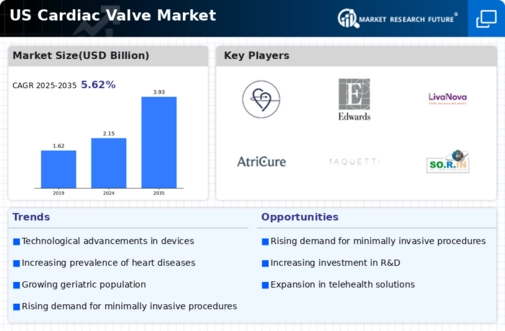The US Cardiac Valve Market is characterized by a dynamic and competitive landscape that encompasses a variety of players committed to innovation and market expansion. The competition in this sector is driven not only by the demand for advanced treatment options for valvular heart diseases but also by the technological advancements that enhance device performance and patient outcomes. Key factors such as regulatory approvals, collaborations, and varying product portfolios further shape the competitive environment.
Companies in this market are constantly strategizing to improve their market share by focusing on product development, clinical studies, and enhancing patient and physician satisfaction through better service and support.
Cardiac Dimensions has established itself as a noteworthy player within the US Cardiac Valve Market, leveraging a distinctive approach that emphasizes innovative solutions for heart valve assessment and management. The company’s strengths lie primarily in its advanced technologies that offer comprehensive imaging capabilities for cardiac valve evaluation, thus empowering healthcare professionals to make informed decisions. With a strong emphasis on research and development, Cardiac Dimensions continues to strengthen its position in the market by introducing new features and improving existing products.
By focusing on partnerships with leading healthcare providers and specialists, the company enhances its reach and credibility in the highly competitive realm of cardiac care, ensuring that it remains a relevant and trusted name in the industry.
Edwards Lifesciences is a significant force in the US Cardiac Valve Market, known for its pioneering technology and extensive range of products and services targeting heart valve diseases. The company is widely recognized for its transcatheter heart valve therapies, which cater to patients with aortic and mitral valve conditions, among others. Edwards Lifesciences enjoys a robust market presence, significantly bolstered by strategic mergers and acquisitions that have expanded its product portfolio and technological expertise.
The company's commitment to innovation is evident in its continuous development of minimally invasive surgical techniques and devices, which resonate well with current trends in patient care. Additionally, the strong focus on clinical research and collaborations with leading cardiologists and medical institutions enhances the company's credibility and leadership in the market, positioning it favorably against competitors while contributing to improved health outcomes for patients in the US.























Leave a Comment